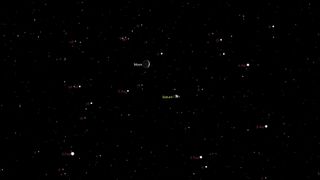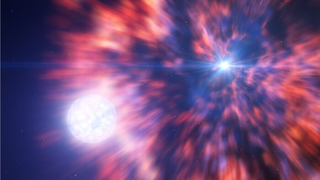
Robert Lea
Robert Lea is a science journalist in the U.K. whose articles have been published in Physics World, New Scientist, Astronomy Magazine, All About Space, Newsweek and ZME Science. He also writes about science communication for Elsevier and the European Journal of Physics. Rob holds a bachelor of science degree in physics and astronomy from the U.K.’s Open University. Follow him on Twitter @sciencef1rst.
Latest articles by Robert Lea

2nd image of 1st black hole ever pictured confirms Einstein's general relativity (photo)
By Robert Lea published
A second image of the first black hole ever pictured by humanity, the supermassive black hole in M87, taken one year later shows its shadow persists just as Einstein predicted.

New mystery object could be lightest black hole ever seen
By Robert Lea published
The MeerKat Radio Telescope discovered an unknown object in the Milky Way heavier than the largest neutron star but lighter than the smallest black holes.

The moon once had way more water than we ever imagined, lunar meteorite reveals
By Robert Lea published
A new examination of a lunar meteorite revealed a mineral that could change our understanding of water on the moon, showing its crust was water-rich around 4 billion years ago.

James Webb Space Telescope discovers oldest and most distant black hole ever seen
By Robert Lea published
The James Webb Space Telescope has spotted the oldest and most distant black hole ever seen. The discovery could explain how supermassive black holes grew so quickly.

When is the Winter Solstice and what happens?
By Robert Lea last updated
Reference Winter Solstice has long marked a time of rebirth, behind it are fascinating astronomical events.

Moon rock revelations could solve lingering lunar geology puzzle
By Robert Lea published
High-temperature experiments conducted on Earth with lunar rock samples may have finally revealed how a unique type of rock was created and distributed on the moon.

Hubble Telescope reveals galaxy that hosted a supernova 2.5 billion times brighter than the sun (photo)
By Robert Lea published
The Hubble Space Telescope zoomed into a galaxy 150 million light years away to study a supernova that released 2.5 billion times more energy than the sun, resulting in a stunning image.

Scientists discover cosmic fossil created by erupting supermassive black hole
By Robert Lea published
Giant clouds of cold gas in NGC 4945, were blasted through the spiral galaxy when its central black hole erupted 5 million years ago.

Decade-long Dark Energy Survey offers new insights into the expansion of the universe
By Robert Lea published
Scientists studied 1,500 supernovas to better understand dark energy and the results call the standard model of cosmology into question.

See a thin crescent moon meet up with Saturn tonight
By Robert Lea published
The nearly new moon is set for a close approach to the gas giant Saturn on Sunday, Jan. 14, at which time the two celestial bodies will also be in conjunction.

Surprise gamma-ray discovery could shed light on cosmic mystery
By Robert Lea published
An unexpected and unexplained gamma-ray signal from beyond the Milky Way found among 13 years of NASA Fermi Telescope data could be linked to another cosmic mystery.

Wispy ice clouds may form above Venus' hellish surface
By Robert Lea published
The surface of Venus is a hellscape with temperatures hot enough to melt lead, but some regions of its atmosphere high over the surface remain cool enough to harbor ice and birth ghostly clouds

James Webb Space Telescope catches young planetary system by its dusty 'cat's tail' (photo)
By Robert Lea published
The James Webb Space Telescope has caught the young planetary system Beta Pictoris by the tail seeing a new structure of dust that resembles the lower half of a cat.

Newfound Earth-size exoplanet has a scorching-hot lava side
By Robert Lea published
NASA's exoplanet-hunting TESS spacecraft has discovered an Earth-sized alien world called HD 63433 d that is surprisingly young and has a hemisphere of scorching-hot lava.

Astronomers accidentally discover 'dark' primordial galaxy with no visible stars
By Robert Lea published
Astronomers inadvertently discovered a "dark" galaxy rich in gas but lacking stars when they pointed the Green Bank Telescope in the wrong direction.

See the elusive planet Mercury at its best and brightest on Friday
By Robert Lea published
The elusive planet Mercury reaches its furthest point from the sun on Friday (Jan. 12), with this separation allowing skywatchers a rare chance to spot the tiny planet.

'Missing link' supernova connects star's death to birth of black hole or neutron star
By Robert Lea published
Astronomers have discovered a "missing link" supernova that directly connects the death of a massive star to the birth of a black hole or a neutron star.

China launches 'lobster eye' Einstein Probe to study black holes, neutron stars and more (video)
By Robert Lea published
On Jan. 9, China launched its Einstein Probe to observe the X-ray sky, hunting for high-energy light from neutron stars, feeding black holes and other exotic objects.

The mystery of vast 'cosmic ORCs' — odd radio circles that encompass entire galaxies — may be solved
By Robert Lea published
Mysterious "odd radio circles" or ORCs that compass entire galaxies may have finally been explained, with astronomers pointing the finger at winds from bursts of supernova star explosions.

James Webb Space Telescope spots hint of mysterious aurora over 'failed star'
By Robert Lea published
The James Webb Space Telescope has spotted signs of a ghostly aurora over a 'failed star,' in the form of infrared emissions from methane in the brown dwarf's atmosphere.

The age of the private moon mission has begun
By Robert Lea published
Astrobotic's Peregrine Lander has set the stage for a new era of commercial missions to the moon in the coming years.

Private Peregrine lander launches to the moon: What science could it do?
By Robert Lea published
Astrobotic's Peregrine moon lander launched today (Jan. 8) with five NASA science payloads aboard. Here's what the experiments are designed to do.

Floating 'magic islands' on Saturn's moon Titan may be honeycomb-shaped snow
By Robert Lea published
On Saturn's largest moon, Titan, snows of organic compounds may form glacier-like honeycomb chunks in methane lakes, appearing as floating "magic islands."


